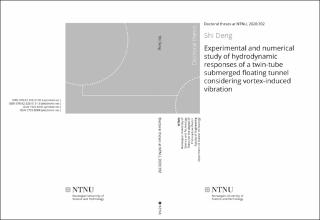| dc.contributor.advisor | Moan, Torgeir | |
| dc.contributor.advisor | Fu, Shixiao | |
| dc.contributor.advisor | Gao, Zhen | |
| dc.contributor.author | Deng, Shi | |
| dc.date.accessioned | 2020-11-25T09:43:14Z | |
| dc.date.available | 2020-11-25T09:43:14Z | |
| dc.date.issued | 2020 | |
| dc.identifier.isbn | 978-82-326-5131-3 | |
| dc.identifier.issn | 2703-8084 | |
| dc.identifier.uri | https://hdl.handle.net/11250/2689499 | |
| dc.description.abstract | A pontoon-supported submerged floating tunnel (SFT) is a reasonable means crossing a fjord with large depth and width. A relevant design of such a tunnel consists of two identical tubes in a tandem configuration and suspended approximately 20-30 m below the mean sea level. The two tubes are rigidly connected by large diameter diagonal truss elements. The natural frequencies of the low-order modes of the full-scale SFT (the first vertical motion-dominant mode and the first two lateral motion-dominant modes) are well within the energy content of the spectrum of vortex shedding induced forces and the difference-frequency wave excitation force. The vortexinduced vibration (VIV) and wave-induced hydroelastic response represent the main challenges in the design of the SFT. Regarding the above two considerations, this work aims at investigating the following aspects: (1) VIV features of a tandem twin-cylinder model and the lift and drag coefficients used in the simplified time domain VIV prediction method. (2) Hydrodynamic features of the SFT considering the 2nd order wave force acting on pontoons, short-crested waves and VIV.
A series of self-oscillation tests were first conducted with an elastically supported rigidly connected tandem twin rigid-cylinder model, to gain a better understanding of the VIV features of an SFT with respect to the ow velocity, spacing distance and submergence. Nondimensional parameters including the reduced velocity, spacing and submergence ratios build relations between the test model and prototype. The crossow (CF) response amplitude and lift force coe_cients were observed to be strongly related to the spacing distance and ow velocity, as expected. The interaction between the twin cylinders leads to a smaller critical reduced velocity (corresponding to the initiation of the VIV) and response frequency than those of a single cylinder when the spacing ratio is less than 4. The lift forces on the two cylinders strongly depend on the reduced velocity, but their rates of change are different. This difference induces an extra torsional moment, which is also sinusoidal in time but quadratic in the ow velocity. An abrupt in crease in the torsional moment is observed at a small reduced velocity when the spacing ratio is 2, and a large final constant value is found in the case of a spacing ratio equal to 4. In addition to the CF lift forces, VIV also strongly amplifies the inline (IL) drag forces, and they achieve their maxima coincidently with the response amplitude. Two drag forces are in direction with each other in the VIV condition rather than opposite directions in stationary result for spacing ratios of 2 and 3. The influence of the free surface on the response amplitude and drag forces can be neglected when the newly defined nondimensional depth h' (h0 = fnhU , where U, fn and h denote the flow velocity, natural frequency and submergence, respectively) is larger than 0.55.
Regarding the wave-induced hydroelastic features, the 2nd order wave forces dominate the lateral motion by exciting the low frequency eigenmodes but have small effects on the vertical motion. The long-crest first order waves induce nearly twice as large lateral bending moments (Mz) as shortcrest waves, by including the 2nd order forces, the short-crest waves lead to a large Mz due to that they can excite both the 1st and 2nd natural modes in the lateral direction. Based on the simplified VIV prediction method (in which, the cross flow hydrodynamic force is modelled as a summation of the vortex-induced force relying on self-oscillation tests and the damping force based on the Morison equation), the maximum standard deviation of the vertical motion (STD/D 0:31) and the corresponding bending moment at the middle part is much larger than that induced by the long-crest waves. Except for the VIV in the central long span between pontoons, the VIV excitation is limited. | en_US |
| dc.language.iso | eng | en_US |
| dc.publisher | NTNU | en_US |
| dc.relation.ispartofseries | Doctoral theses at NTNU;2020:392 | |
| dc.relation.haspart | Paper 1: Deng, Shi; Ren, Haojie; Xui, Yuwang; Fu, Shixiao; Moan, Torgeir. Experimental study of vortex-induced vibration of a twin-tube submerged floating tunnel segment model. Journal of Fluids and Structures 2020 ;Volum 94. https://doi.org/10.1016/j.jfluidstructs.2020.102908 | en_US |
| dc.relation.haspart | Paper 2: Deng, Shi; Ren, Haojie; Xu, Yuwang; Fu, Shixiao; Moan, Torgeir; Gao, Zhen. Experimental Study on the Drag Forces on a Twin-tube Submerged Floating Tunnel Segment Model in Current. Applied Ocean Research 2020 ;Volum 104.
https://doi.org/10.1016/j.apor.2020.102326 | en_US |
| dc.relation.haspart | Paper 3: Deng S, Xu Y, Ren H, Fu S, Li S, Moan T, Gao Z. Numerical simulation of wave-induced hydroelasticity and ow-induced vibration of a twin-tube submerged oating tunnel. | en_US |
| dc.title | Experimental and numerical study of hydrodynamic responses of a twin-tube submerged floating tunnel considering vortex-induced vibration | en_US |
| dc.type | Doctoral thesis | en_US |
| dc.subject.nsi | VDP::Technology: 500::Marine technology: 580 | en_US |

